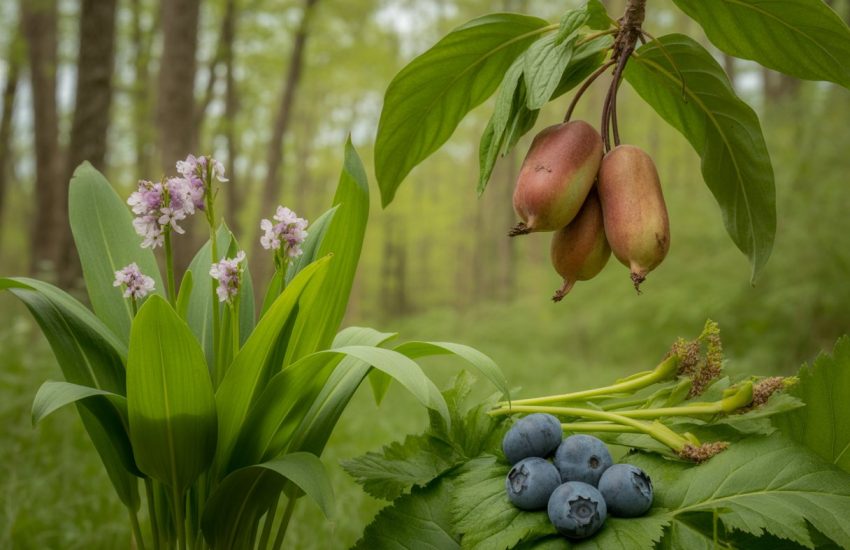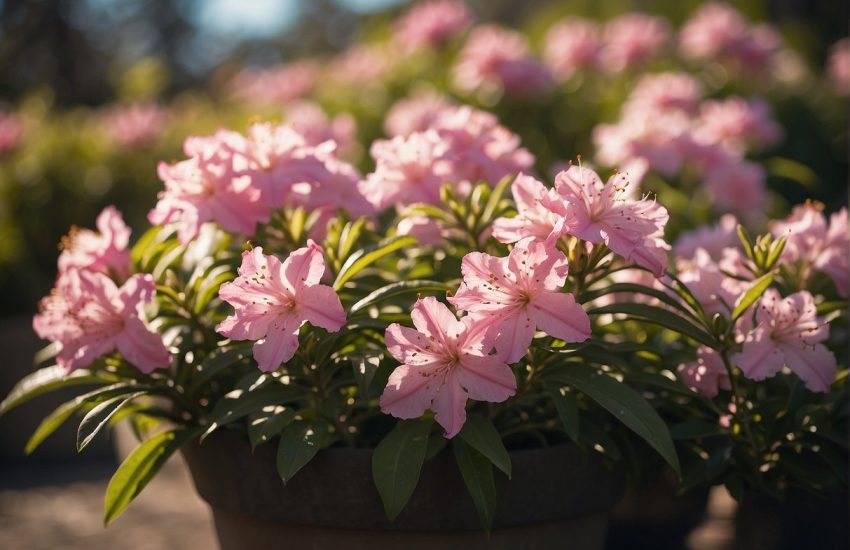20 Native Plants That are Sure to Enhance Your Arizona Pollinator Garden
Are you looking to attract bees, butterflies, and other pollinators to your Arizona garden? We’ve compiled a list of 20 nectar- and pollen-rich plants that are sure to thrive in Arizona’s arid and semiarid subtropical climates. Pollinators are like the essential workers of a garden. The vast majority of fruits and vegetables cannot grow unless they are subjected to cross-pollination.
Pollinators are essential to ecological survival. Without pollinators, neither humans, animals, nor plants could exist. In fact, 80% of the world’s crops require pollination. According to a United Nations report, over 40% of invertebrate pollinators and 16.5% of vertebrate pollinators are currently at risk of extinction. The worldwide decline of pollinator populations comes as a result of widespread pollinator habitat reduction, climate change, and increased pesticide use.
Before you dig in, check out our tips for planting a pollinator garden!
Avoid Pesticides
Insecticides, fungicides, rodenticides, and herbicides can harm and even kill pollinators. Studies show that pesticides disrupt bees’ memory, navigation, and reproduction. Researchers have even found traces of pesticides in hive products. You can avoid pests by selecting pest- and disease-resident plantings. Catnip, mint, and nasturtium are just a few plants that are known to deter unwanted garden guests. You can also use integrated pest management practices to responsibly and safely remove pests from your yard and garden.
Plant Native Varieties
Do your best to incorporate native plants into your pollinator garden. Native plants are ready-made for their motherland. As a result, they typically require fewer interventions. Native pollinators are also more likely to feed on native plants. After all, native plants tend to offer the full package, including the ideal nectar, pollen, seeds, shelter, and nesting spots.
Create the Ideal Environment
If you want to attract lots of pollinators, you’ll need to create the ideal pollinator ecosystem. Integrate a wide variety of plants, including flowering trees, shrubs, vines, annuals, and perennials. Mix sun- and shade-loving varieties. Make sure your garden has plenty of areas with direct sunlight and wind protection. Integrate fresh, accessible water. Add nonliving garden elements that could serve as nesting spots. Integrate flowering plants of different sizes, textures, shapes, and colors. Last but not least, make sure that the plants you select are capable of producing pollen and nectar.
Bees tend to prefer blue, white, purple, and yellow blooms and flowers with wide, flat surfaces. Butterflies are attracted to narrow, tubular flowers and intense floral aromas. On the other hand, hummingbirds and other birds tend to prefer red, yellow, and orange flowers. Meanwhile, bats and moths tend to like flowers that open at night and buds that have pungent or fruit-like odors. Thus, you need to mix things up if you want to attract more than one kind of pollinator.
Reap the Benefits of Succession Planting
Check out the North American Pollinator Protection Campaign’s guide for tips on how to select the best plants for your Arizona pollinator garden. This guide included a chart of flowering periods of several pollinator-friendly trees, shrubs, flowers, and vines. With the help of their guide and a green thumb, you can have your Arizona garden blooming from January to December.
Embrace Variety
Be sure to diversify your garden. Pollinators have very specific plant preferences. They might like a plant because of its color, shape, fragrance, nectar, or pollen. You can attract a wide variety of pollinators by propagating plants with varied floral traits.
Pollinators are also more likely to hang around if they’ve got access to the food they need for all of their life stages. Butterflies, moths, and bees go through four unique stages: eggs, larvae, pupae, and adults.
Build a Dynamic Habitat
Pollinators are much more likely to hang around when all of their needs are met. Hollow logs, nesting boxes, and bee hotels encourage long-term habitation.
Add a water source, such as a bird bath or lily pond so that your pollinators will have somewhere to quench their thirst.
Planting pollinator favorites is an excellent starting point. However, you’ll need to do more if you want to create a truly pollinator-friendly environment. Encourage your neighbors to embrace pollinator-friendly landscaping practices. Reach out to your local agricultural extension to see what your community could be doing to further support pollinators.
Choose Plants that Attract and Sustain Pollinator Attention
Many pollinators prefer flowering plants with compound inflorescences, or multiple clusters of flowers, to those with single florets. These clusters of flowers allow pollinators to cross-pollinate flowers and consume lots of nectar without leaving the comforts of a single plant.
20 Native Plants for an Arizona Pollinator Garden
White Yarrow (Achillea millefolium)
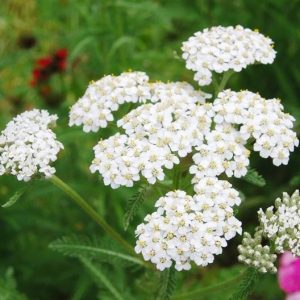
White yarrow is a member of the aster family. It is a perennial herb with dome-shaped clusters of pink, white, or yellow flowers and spindly green leaves. White isn’t native to the Arizona desert. However, its ability to resist drought and tolerate poor soil makes it an obvious choice for any desert garden. Western yarrow is a native variety of the plant. However, its weedy appearance makes it a less popular pick for landscaped gardens.
An aster’s flowers blossom from April to October. Its main benefactors are bees and beetles.
Aster spreads from an underground rhizome. Its creeping root stalks enable it to flourish and spread quickly. The plant can become weedy if it’s left to spread voluntarily.
Indigo Bush (Amorpha fruticosa)
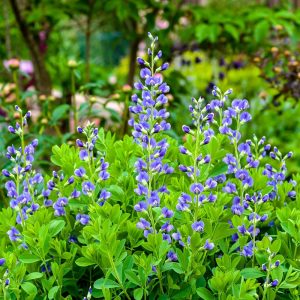
This flowering evergreen fairs well in both wet and dry soil. The spikey cones of pea-shaped blossoms appear from April to June. Bumblebees, butterflies, and other winged pollinators are big fans of the indigo bush’s nectar. Meanwhile, caterpillars are attracted to the plant’s bluish-green foliage.
A full-sized indigo bush can grow up to 4 feet in height. It can do so without regular watering or amendment. If you’re planting your indigo bush from seed, it could take anywhere from three to four years for the plant to flower.
Beloperone (Justicia californica)
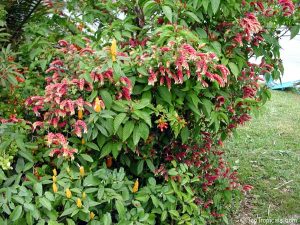
This nectar-rich plant is native to the deserts of Arizona. It’s a semi-evergreen Deciduous shrub with tubular red, orange, and yellow flowers, heart-shaped leaves, and capsule seeds. The plant’s flowers sprout continuously throughout the growing season. These plants can stay in bloom for 10 months to a year.
Beloperone is sometimes referred to as a hummingbird bush. These tiny birds love to frequent the plant. Sparrows and linnets are also big fans of the shrub. Meanwhile, Tiny Checkerspot, Phason Cresent, and Cobubatha dividua are three moths that thrive on belpoerone nectar.
While beloperone typically grows in the wild, it can also be cultivated. These stubby bushes often serve as decorative landscape elements. They require full sun and fast-draining, dry soil. They’re a common element in desert-based bird and pollinator gardens.
Saguaro (Carnegiea gigantea)
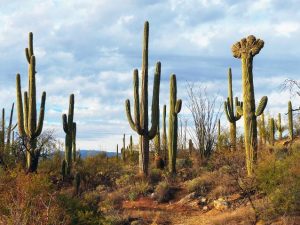
These barrel-shaped cacti are only grown in Arizona’s Sonoran Desert. The plant’s milky yellow blooms are an integral part of the desert ecosystem.
This slow-growing plant is not designed for cultivation. However, you may find that you already have one growing on your land. If this is the case, you’ll be happy to know that Saguaro flowers’ nectar is consumed by native bats, birds, bees, and ants. Once the plants are pollinated, they produce thousands of black seeds. These seeds are eaten by desert mammals, birds, and insects.
Rock Verbena (Glandularia pulchella)
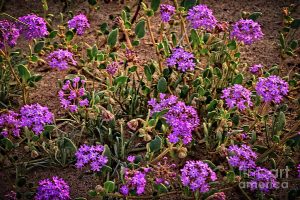
This perennial plant boasts a dense mat of dark greenery and loads of delicate purple flowers that last from spring to fall. Rock Verbena trails and mats easily. Thus, it is a popular landscape groundcover and container filler.
The plant’s violet blooms attract all sorts of bees, butterflies, and hummingbirds. Its long-blooming flowers produce enough nectar to supply a small army of pollinators.
Tall Verbena (Verbena bonariensis)
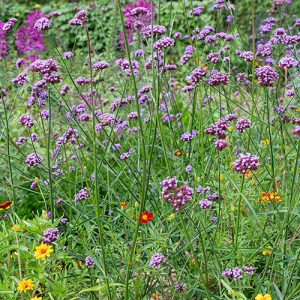
Verbena bonariensis is a quasi perennial with bursts of lavender flowers. The plant’s scant foliage makes its flowers even more accessible to pollinators.
In hot climates, this plant is likely to reseed itself. Since it trails and clumps easily and can withstand regular disturbances, it is favored as a groundcover. Tall verbena is also heat- and drought-resistant. It’s native to the southwestern United States, Mexico, and Central America.
Tall verbena is one of the few flowering plants that can sustain pollinators into the fall. Its violet blossoms tend to last from late August to late October. Thus, it serves as longstanding nectar and pollen buffet.
Goodding’s verbena is another type of verbena that is native to Arizona. This plant produces large clusters of lavender flowers. Goodding’s verbena provides nectar for butterflies, moths, and other pollinators. It blooms in February. However, its flowers can last into April. As such, it is one of the first plants to become available to pollinators.
Arizona Milkweed (Asclepias angustifolia)
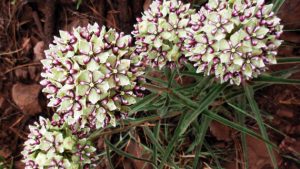
Did you know that Arizona has 29 native varieties of milkweed? Milkweed plants produce pinkish-purple flower clusters and pod-like fruits. By adding a bit of it to your garden, you’re sure to boost your backyard pollinator numbers. After all, milkweed nectar is the main host plant for monarch butterflies. Moths, bees, and other native pollinators can also reap the benefits of this flowering plant.
Milkweed should be planted by seed. However, you should not accept the plant to flower during the first year. Popular Arizona varieties include desert milkweed, butterfly milkweed, and green comet milkweed.
Bee Balm (Monarda)
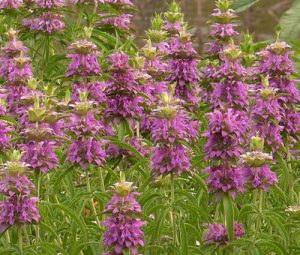
Bee balm is a flowering perennial that’s native to North America. Its brightly colored blooms are a common element in decorative gardens and flower beds. Plant it once, and you’ll reap its benefits for years to come. As its name implies, it’s a favorite of bees. You’ll also find hummingbirds, butterflies, moths, and wasps hovering over its tube-shaped flowers.
Joe Pyes
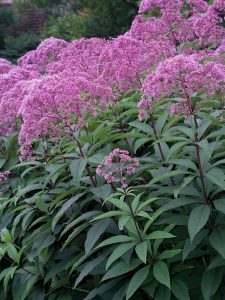
These tall wildflowers do an excellent job of attracting butterflies and bees. It’s also a host plant for various moth larvae. The lofty pink flowers make a great addition to any perennial garden. This plant prefers ample sun and moderate moisture.
Goldenrod
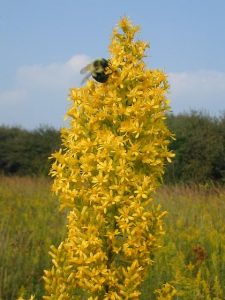
Goldenrod is one of our top recommendations for anyone who’s looking to create a butterfly garden. This underappreciated perennial feeds over 100 different caterpillars. Its nectar serves as food for dozens of different butterflies and moths. Goldenrod is typically in bloom from late August to September.
Aster
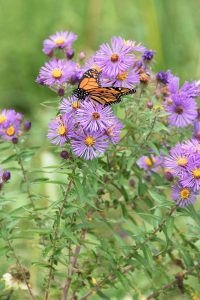
Aster is another plant that’s beloved by most pollinators. These playful purple and yellow flowers attract everything from bumble bees to moth caterpillars. Aster grows well in most soil.
Sunflowers
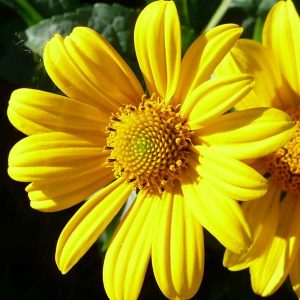
Sunflowers can be planted anytime between February and July. These hardy annuals can withstand intense sun and heart. Thus, they’re an excellent addition to any Arizona garden. Their brightly colored petals and large florets serve as a safe harbor for bees, butterflies, and other nectar-loving insects. Plant your sunflowers in groups to encourage cross-pollination and non-stop nourishment.
Purple Coneflower (Echinacea purpurea)
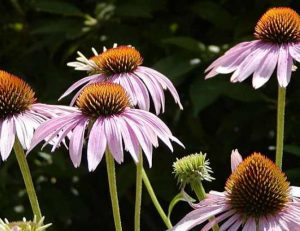
Purple coneflowers are perennial flowers that lure in all sorts of birds, bees, and butterflies. These hardy plants do not do well in intense heat. If you sow your echinacea in late fall or early winter, it should grow quickly and last for at least one season.
(Floss Flower) Ageratum
This low-lying desert plant produces pompom-like lavender flowers. This hardy perennial can typically only withstand a single season in the desert-like climate of Arizona. It produces enough nectar to support
Dahlberg Daisy
Dahlberg Daisy is a low-lying annual with an abundance of daisy-like yellow flowers. In frost-free regions like the Southwest, the Dahlberg daisy may return year after year. The delicate blooms attract a wide range of pollinators, including bees and butterflies. Many gardeners use Dahlberg daisies as a groundcover and filler.
Candy Barrel Cactus (Ferocactus wislizeni)
These cylindrical cacti produce whorls of burnt orange flowers. While many cactus flowers do not last more than a few hours, the barrel cactus’s flowers tend to stay in bloom for several weeks. The candy barrel cactus typically blooms in the summer. The cactus’s primary pollinators are cactus bees. These native pollinators are reliant on cactus flowers.
These spiky succulents prefer warm temperatures, dry soil, and direct sunlight. They can be sowed from seed. Though most gardeners opt to transplant grown specimens. Keep in mind that it takes around 30 years for the barrel cactus to reach full maturity. Flowers typically appear when the plant is 15 years old.
Sacred Thorn-Apple (Datura wrightii)
This drought-resident nightshade is typically used as a landscaping groundcover. If you water it regularly, you will have flowers all summer long. It thrives in dry, sandy soil like that found in Arizona.
To only catch is that this plant’s flowers bloom in the evening. Thus, the plant’s primary pollinators are moths and bats. It’s a favorite of hawk moths and sphinx moths.
Do you favor nocturnal pollinators? If so, you’ll want to check out the night-blooming cereus. This cactus produces white flowers that only bloom a single night per year. The flowers are only pollinated by hawk moths. These loyal pollinators will travel great distances to get a taste of the night-blooming cereus’s nectar.
Cereus can be propagated from a cutting. These cacti usually establish roots in just a few weeks.
Catclaw Acacia (Acacia greggii)
This shrub-like plant is adorned with several branches, clawlike thorns, and cylindrical yellow flowers. It produces fragrant flowers that last from spring to fall. Its lengthy blooms and sweet scent help it lure in bees and other beneficial pollinators.
As a bonus, this plant is native to the southwestern United States and northern Mexico. It typically grows along riverbanks and road shoulders. It’s also easy to cultivate and requires very little maintenance. Catclaw acacia should be planted in a sunny area with alkaline soil. Don’t let its sharp protrusions disturb you. Every rose has its thorns!
Red Salvia
Red salvia is an ornamental sage plant with bright red flowers. Its blooms can reach a height of 4 feet. The red blooms stay in bloom from summer to winter. Its ability to withstand droughts makes it an excellent pick for a dry Arizona garden. Its distinct red color and accessible buds make it a favorite of native butterflies and hummingbirds.
You can also plant deep blue Arizona sage, a deer- and rabbit-resilient plant with blue flowers. This variety of salvia is much more likely to attract bumblebees. Mexican bush sage is a shrub-like sage species with violet blossoms. This plant attracts everything from bumble bees to hummingbirds. Many people enjoy the plant’s herbal aroma.
Desert Marigold (Baileya multiradiata)
This hardy perennial produces bright yellow flowers that last from April to November. The 12- to 18-inch blooms have open centers. This makes it easy for pollinators to find them.
The Desert Marigold’s ability to withstand drought and reseed itself makes it the perfect pick for a desert garden. This plant produces plenty of pollen and nectar for bees and other pollinators. According to the Arizona Agricultural Extension, doves, sparrows, and finches enjoy eating the flower’s seeds.

